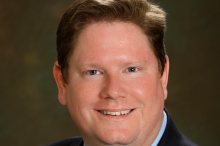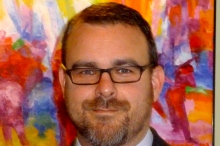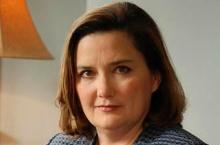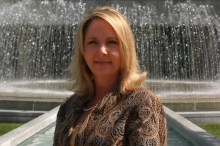Champions of Change Blog
Connecting Communities
Posted by on September 27, 2012 at 4:48 PM EDT Michele Hovet is being honored as a Champion of Change for her efforts in local innovation.
Michele Hovet is being honored as a Champion of Change for her efforts in local innovation.
I believe working for the government is a calling to work for the greater good, and I’m proud to say that I love my job. Each day gives me an opportunity to do great things that extend beyond my immediate experience. And the power of technology magnifies this work. Technology is a catalyst for innovation. Innovation helps connect our communities. Mobile apps, freely-available data, and open-source technology all play a role. I have been fortunate to work for the City of Arvada, a cutting-edge city in Colorado. Because of the city culture and the leadership of our Mayor, Council and City Manager, we have a high performing organization. We hire the right people to focus on the citizen experience by, as our mission statement says, “Continuing to Build a Great Community.”
Technology has enabled three important projects in Colorado. First, shared services around open source software; second, putting arts back in the class room through tablets and apps; and third, enabling transparency through a shared data repository.
It is important to provide quality services to our citizens. Our open source web content management system (CMS) called Xpress CMS, designed by staff, is cutting edge. It is sharable, flexible, social, transparent, secure, and scalable. Genius is born in the spirit of collaboration. Two minds are better than one, right? Why not utilize governments’ collective wisdom via shared technologies to provide a flexible platform that actually creates efficiencies, reduces red tape and fosters creativity for the greater good. Our goal is to expand the use of XPRESS CMS across the U.S. Get it in the hands of those that need it and those that can enhance it. Boulder, Colorado is Arvada’s first partner, and plans to go live early in 2013 on the Xpress CMS platform. One of the founding Xpress CMS designers, Sean Hudson, is traveling with me to the White House.
But how else can we make a difference with technology? We started by focusing on the kids. The City of Arvada is working with the Arvada Center for the Arts and Humanities to infuse digital, tailor-made, and multi-disciplinary arts into classrooms by using XPRESS CMS with Digital Distance Education Services of Colorado (Digital DESC—pronounced desk). Digital DESC aims to increase access to arts opportunities for students. It promotes partnerships among educators, arts institutions and technology providers. The XPRESS CMS architecture will create a foundation for Digital DESC to deliver an online, standards-based art curriculum to multiple schools while empowering teachers with new technology such as tablets and apps. Our goal is to turn the school’s focus of science, technology, engineering and math (STEM) into STEAM, by including the arts.
We also focus on other shared services in Colorado. We founded OpenColorado as a community asset for all local government data in Colorado. We are helping make government data (like geospatial, crime, and transit data) accessible to the public. The main resource for this effort is the OpenColorado data catalog that allows anyone to index open data and make it searchable. In addition, the technology we use allows governments and community organizations to publish their data on their own website. Thus, creating two access points to the data and unleashing the potential of this community resource. We are hosting, organizing, and partnering with others to educate people on what is possible in the government space and to help anyone realize the new possibility of a government that is simple and easy-to-use. Our flagship event is CityCamp Colorado, which is an “un-conference“ devoted to helping government and community leaders bring about an improved government. In addition, we have partnered with PlaceMatters to organize Code for Communities, a civic hacking event to help create solutions and applications to help peoples live.
With technology and innovative public servants, anything is possible.
Michele Hovet is the Deputy City Manager for the City of Arvada, Colorado
Learn more aboutEntrepreneurial Local Governments -- A Catalyst for Collaboration and Innovation
Posted by on September 27, 2012 at 4:04 PM EDT Rob White is being honored as a Champion of Change for his efforts in local innovation.
Rob White is being honored as a Champion of Change for his efforts in local innovation.
Being named a White House Champion of Change is a strong validation for our work to build collaborative relationships between government, academia, and industry. Too often local governments become tied to process over opportunity and limit their ability to innovate or become true agents of change. In my role as an economic developer, I have been given the incredible chance to work across sectors and regions to translate the entrepreneurial ecosystem present in Silicon Valley into a living network of government advocacy, research collaboration, and industry investment.
Starting in 2007, I was given the unique opportunity to work closely with two premier U.S. research institutions Sandia National Labs/CA and Lawrence Livermore National Lab. We focused on creating new partnerships and economic development prospects in Livermore, the eastern-most region of the San Francisco East Bay area. Concurrently, Lawrence Livermore and Sandia/CA were creating plans for the Livermore Valley Open Campus, and we worked to identify numerous community benefits that could be realized by partnering with the Labs in their endeavors.
The most significant outcome from this engagement is the i-GATE Innovation Hub, which was co-founded in 2010 with a colleague at Sandia/CA. Formally recognized by the State of California as an emerging innovation ecosystem, we built coalitions throughout the East Bay and Sacramento regions in order to address a range of issues in developing a strong entrepreneurial climate that would increase new technology startups and commercialization in conjunction with the Labs. These challenges included a lack of entrepreneurial support services, growth capital, innovation networking, and academic interactions. The regionally-focused i-GATE initiative was designed to address these gaps in the research-to-commercialization continuum thus increasing local capacity for technology transfer.
As an example of local government entrepreneurship, I leveraged my small City of Livermore departmental resources to established two 501c3 nonprofits for the i-GATE iHub. The organizations are tasked to support small technology businesses and create an accelerated growth environment to maximize the economic potential of sustainable transportation, clean-energy, and high performance computing technologies. i-GATE programs also include the NEST Commercialization Center, which serves small and emerging technology companies by leveraging technical assistance, expertise, and connectivity with Sandia/CA and Lawrence Livermore user facilities, R&D programs, and technology transfer programs. The NEST is partnered with federal agencies such as the US Commercial Service, Small Business Development Centers, USDA, and MANEX/NIST to increase client access to services without duplicating other programs. After just 15 months of operation, the i-GATE NEST has helped to create over 50 direct and 100 indirect jobs.
Recognizing that the Livermore region was also in need of additional academic opportunities, I helped create the Academic Alliance which brings together academic and research institutions to support the mission of i-GATE, the Labs, the Livermore Valley Open Campus. This Alliance has resulted in development of partnerships with the University of California at Berkeley and Davis, the California State University System, the regional California Community Colleges, and Midwest universities such as University of Oklahoma. These partnerships focus administrative connection and researcher interaction through the i-GATE consortium in order to leverage technology transfer, accelerate commercialization, assist workforce development and training, and increase innovation.
Over the last 30 months, my i-GATE efforts have created a proactive, two-way link between national laboratories and entrepreneurs, industry, innovation networks, venture capital firms, universities, business support services, and economic development resources in order to accelerate the commercialization of innovative energy technologies and grow a cohesive innovation ecosystem.
I am humbled and honored to be selected as a Champion of Change. From this recognition, I hope all local government employees are reminded that the public sector, too, can be entrepreneurial, have a positive impact and contribution to economic and business ecosystems, and can create change that propels our nation’s efforts on the forefront of innovation.
Rob White is the Director of Economic Development for the City of Livermore and the Interim CEO of the i-GATE Innovation Hub, a broad super-regional partnership that is focused on Lawrence Livermore National Laboratory and Sandia National Laboratories/CA as economic engines.
Learn more aboutGovernment as a Connector
Posted by on September 27, 2012 at 3:48 PM EDT Doug Matthews is being honored as a Champion of Change for his efforts in local innovation.
Doug Matthews is being honored as a Champion of Change for his efforts in local innovation.
I've often joked that I didn't have a choice in entering public service—my father was a local police chief and my mother was an emergency room nurse. My first job was as a life guard, where I also taught swim lessons at the city recreation center. My high school scholarship essays invariably turned to politics, service, and governance in America.
So when it came time for college I did the next logical thing: I studied advertising and public relations. That's right. I abandoned all of my leanings to public service, thinking that the only way for me to exercise my creative side was to abandon that path and pursue something else entirely. I had the same unfortunate images that many do of the "government bureaucrat," destined for a life of mind-numbing rules, regulations, and protocols that would leave the most creative soul a robotic image of oneself by the age of 30.
But something interesting happened along the way. I started my career in public service working as an intern for the Orange County Government, and I discovered a whole group of people that were genuinely working to change the way government worked. Back then, it was the "reinventing government" crowd. Soon, I realized that what I thought would be temporary employment while I found something bigger was actually the very beginnings of the "something bigger" I was meant to work on.
Almost 20 years later, there's something very significant and palpable happening in government today at all levels. And I'm lucky enough to be in a community—Austin, Texas—that is ripe for rethinking government's role in our lives.
At the 2011 Code for America Summit, there was quite a bit of discussion about "government as a platform." I had the opportunity to meet some extraordinary people doing extraordinary things in local government. That included Nigel Jacob and Chris Osgood in Boston, Jeff Friedman in Philadelphia, Jay Nath in San Francisco, and a host of others.
Much of the talk has been about the value of opening up government data, and creating an environment for development of open-source solutions to the challenges of governing. But to me, that's one piece of the puzzle. "Government as a platform" is giving way to "government as a connector." That's where I've found my sweet spot.
A few years ago, Daniel Pink wrote about the right-brain revolution in his book, “A Whole New Mind.” One of the cornerstones of his modern brand of leadership is the "connector" – those who see the connectivity and opportunity between seemingly unrelated ideas. There's a unique place for connectors in government –finding and fostering the nexus where government, entrepreneurs, social service agencies, and the average citizen can connect to make a better world.
In Austin, we're just beginning that journey. In the past two years, we launched one of the largest municipal open source websites in the nation, including a portal for open data, and began our partnership with Code for America. That partnership has created new tools for local wildfire preparedness, started a conversation about improving systems that support animal welfare and began something that might be even more important –a conversation between private citizens, local technology groups, and the City about how we can collaborate to improve the way we serve the public.
Anyone who has heard folks like Jen Pahlka or Todd Park speak knows that there's a new brand of thinking making its way through government at all levels, and I'm just happy to be doing what I can to be part of the movement.
Doug Matthews is the Chief Communications Director of Austin, Texas
Learn more aboutEnsuring Local Budget Choices Are Understood
Posted by on September 27, 2012 at 3:41 PM EDT Mary Bunting is being honored as a Champion of Change for her efforts in local innovation.
Mary Bunting is being honored as a Champion of Change for her efforts in local innovation.
I became City Manager of Hampton, Virginia in January 2010 and began to prepare my first city operating budget as the decline in home values hit and the recession limited income growth of our residents. The city had an initial budgetary shortfall of $19 million. Even though cuts were required, my past experience told me that – without a different approach – community consensus on what were acceptable cuts would be nearly impossible to achieve.
To many citizens, the budget is an overwhelming document that’s hard to understand – and an easy target for criticism, especially when cuts are required. Yet, budget decisions drive nearly everything that happens in local government for the next year by setting the allocations of resources.
Traditionally, managers make such choices based on many logical factors, such as impact of programs and return on investment, but every program has a constituent group that values it. Once budgets are released, those stakeholders complain about the cuts. Often, council members – wishing to be responsive to resident feedback – then choose another set of cuts that affect a different group of people who have less time to respond to the impacts before the budget is eventually adopted. In the end, no one is happy and many will not understand the full effects until the cuts start to impact them on a daily basis. I believed there was a better way.
With help from a lot of people, we decided to engage our residents more proactively on the front end of the process – before staff recommendations were solidified and presented. By using an aggressive outreach program of large public gatherings—including adding instant polling technology that allowed every person to voice an opinion on every issue and immediately see the group polling results—small neighborhood and organizational chats, public comment drop-boxes, Internet chats, social media, and internet polling, we dramatically increased the number of people who actually participated in these crucial discussions.
By taking issues to residents, we worked to make the budget a much less intimidating issue. We worked to reduce dollar decisions to value choices that relate to other financial decisions that citizens make in their daily lives. For example, what services are “needs” vs. “wants”? Are you satisfied with the level of police protection, or should we do more? To save money, can we reduce hours at parks, libraries, and community centers, or should we consider closing some?
The budget isn’t decided by polls, but greater outreach has given city leaders input to help us shape three years of extremely challenging budgets. Moreover, technology has enabled us to reach more people and engage them in their local government. And each year, more people have joined in the discussion, with much of the growth coming from busy working families who are able to contribute their views online.
Because of this extensive outreach and input, budget proposals have been adopted with few changes. Instead of pushback, stakeholders and residents have largely embraced the decisions because they have seen a correlation in the broader community input and the decisions made. Even in the face of difficult choice, Hampton’s citizenry remains satisfied with our local services. Ninety-four percent of residents are satisfied with the level of information available on city services and 93% are satisfied with both the overall work performance and the courtesy of city employees. I believe citizens are satisfied because residents play a role in shaping our decisions. Residents contribute ideas, feel more involved in government, and thus understand the difficult choices we face.
I am honored to have been selected as a White House Champion of Change, but the honor really belongs to all the Hampton residents and staff that came together to ensure local budget choices are understood by the larger community.
Mary Bunting is City Manager of Hampton, Virginia
Learn more aboutAll Change is Local
Posted by on September 27, 2012 at 3:33 PM EDT Ted Smith is being honored as a Champion of Change for his efforts in local innovation.
Ted Smith is being honored as a Champion of Change for his efforts in local innovation.
My boss, Louisville Mayor Greg Fischer, likes to say: “In city government, you’re closer to the customer.” This proximity to citizens – in contrast to state or local government -- is one of the things that lured me from a post in Federal government in Washington, DC, to local municipal government in Louisville, KY.
So much of my job is looking to find new ways to help our neighbors enrich our community, and I believe a city is the best place to incubate innovative change. In my role as Chief of Economic Growth and Innovation for Metro Louisville, Kentucky, I get to work with a spectrum of public, private, and nonprofit entities in Louisville.
We have the tools necessary to help businesses form and grow, but the work is often compartmentalized. For example, we have had a very successful low interest public loan program that has a great history of helping the small business or the distressed business which is important, but we also want to be sure the resources we have are not just saving jobs but supporting job creation.
I got that chance a few months ago when an innovative healthcare start-up was struggling with the lag time in one of the new CMMI Accountable Care Organization programs. This great startup had two co-founders taking risks to improve the way primary care is delivered – actually bringing more care to patients at lower cost. However, the Federal program that pays for these care savings was not going to pay fast enough to keep the lights on for the new startup. And there is no bank willing to secure a loan for a company without revenue or assets and just a letter from HHS offering payment in the future. In short, my team looked at that letter from the Federal government and made the decision that our loan program could recognize that as collateral for a loan that ultimately allowed the company to not only stay in business but begin hiring on schedule to get to those health savings sooner.
If members of our community are willing to risk their own savings to build a company, create new jobs, and improve health in our city and others across the country, maybe there is room to innovate the way government works. That is the context for this recognition from the White House. Government needs to innovate to take some risks, and to be a partner for those entrepreneurs who risk so much more to grow our economy. I’m not sure I deserve this honor, but I’m glad we can find leverage between government programs at different levels to let innovators innovate, create jobs, and improve quality of life on a platform that welcomes it.
Dr. Ted Smith is the Chief of Economic Growth & Innovation for Metro Louisville Government
Learn more aboutBridging the Digital Divide
Posted by on September 27, 2012 at 3:29 PM EDT Carolyn Hogg is being honored as a Champion of Change for her efforts in local innovation.
Carolyn Hogg is being honored as a Champion of Change for her efforts in local innovation.
I have worked for the private and public sectors in the area of banking, healthcare, and local government. In all of those fields, my career has been focused on supporting underprivileged populations, which has helped me develop the skills necessary to maximize limited resources our current economic times. During the recent economic downturn, my staff was reduced by 25 percent. I realized that we needed to find new ways to deliver core services. Recognizing that a city is only as good as the region surrounding it, I also saw an opportunity to reach out to community partners to transform government at the local level. This change in approach and opportunity to partner with Federal departments such as USDA as part of the Strong Cities/Strong Communities (SC2) program opened up conversations with the San Joaquin Valley Regional Broadband Consortium, Office of Community and Economic Development with California State University, Fresno, and other SC2 Federal teams to focus on bringing wireless broadband to the rural area and sharing common applications used among all municipalities throughout the region to maximize public funds.
There is a digital divide in the San Joaquin Valley between the urban core and the rural area. The rural area continues to struggle for connectivity and, if left unaddressed, larger food supply challenges could be faced, according to Robert Tse, USDA, one of my Federal partners from SC2. Our conversation began because we shared a common goal, “how to get connected”. From the city’s perspective, I’m working on a California Government Consortium concept that could transform the way local governments operate by using a shared secure pipeline to the state’s Federated Data Center to share common applications all cities and counties use to conduct business. The problem is the limited funds currently available that are specific to technology.
From USDA’s perspective, the San Joaquin Valley feeds 1/3 of the world with more than 350 different crops grown in our region which makes the San Joaquin Valley unique. Global demands for our crops are increasing as the population expands and becomes more urbanized. Our planet has, at most, 12 percent more land available for growing crops and our current water supply in the Central Valley just meets current demands. We need to “farm smarter” using water sensor technology that has the potential to save the equivalent amount of water in Lake Shasta annually and other innovative technologies that can potentially double our agricultural crop production, reduce energy consumption and double the amount of revenue coming into the Fresno region.
The missing link is wireless broadband in rural areas. Wireless broadband will allow for the use of new “smart-farming” technologies such as remote sensing devices at the field level to assess soil conditions, water and chemical needs, and climate changes and to control equipment such as tractors with GPS capability to plow smartly due to precise farming. Additional beneficiaries include our educational community as they embrace distance learning and mobile connectivity and our healthcare partners for tele-health to provide better patient screening at rural clinic sites.
Under our economic development umbrella, the opportunity to combine California’s strengths – agriculture and technology – will ignite our revitalization efforts by attracting high-tech agriculture companies to the downtown area which has been under-utilized and has become a financial drain. The downtown area is a perfect location for high-tech agriculture companies as we are working with telecommunication carriers to bring ultra-high speed broadband to the downtown corridor and other incentive areas within the city. Doug O’Brien, Deputy Under Secretary for Rural Development, has stated that he “envisions startups making broadband-dependent water sensors and other high tech agriculture equipment in the [San Joaquin] Valley. Tse also said, “Just as railroads brought economic growth to communities that were connected to the rail lines in the 19th century, and water ports provided the same connectivity in to cities in the centuries before, broadband offers the same access to prosperity in the 21st century”.
I see wireless broadband throughout our region, including the underserved areas, as “data” transportation to historical economic drivers.
My vision for the City of Fresno’s success is to partner with our regional stakeholders to bring wireless broadband to our entire community benefitting multiple stakeholders and, under the economic development umbrella, having the tools to help solve agriculture, economic, health, and social problems. Once the availability of ultra-high speed broadband in Downtown Fresno and other incentive areas are in place, the economy in our region will benefit. This infrastructure could serve as the underpinning for development of a regional agricultural technology cluster in Fresno, which means good jobs and would also help address the digital divide for urban and rural residents allowing for “Big Data” innovation.
Carolyn T. Hogg is the Chief Information Officer for Fresno, California.
Learn more about
- &lsaquo previous
- …
- 85
- 86
- 87
- 88
- 89
- 90
- 91
- 92
- 93
- …
- next &rsaquo

